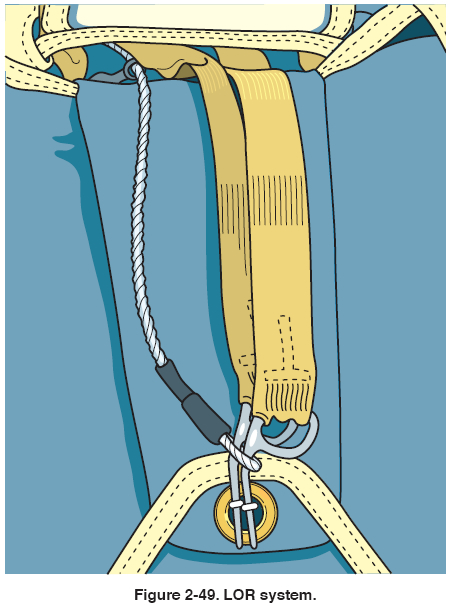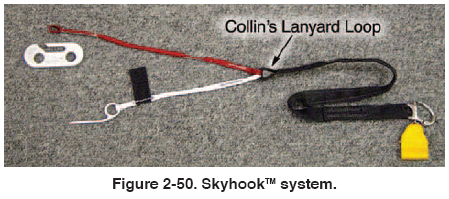Chapter 2
RESERVE STATIC LINE SYSTEMS
A reserve static line (RSL) system is a backup device for
activating the reserve after a cutaway is performed. It
usually consists of a line, webbing, or cable, which connects
one or both main risers to the reserve handle, housing,
or cable. The most common design used today has a
ring through which the reserve ripcord cable is routed.
The riser end attaches to a ring on the riser(s) with a snap
shackle for quick release capability. When the risers are
jettisoned, the lanyard pulls the cable, releasing the ripcord
pin(s), and activates the reserve. This results in a
minimum loss of altitude during the cutaway procedure.
The use of an RSL has saved many lives over the years
due to low cutaways.
Though originally developed in 1964, the RSL concept
did not become popular until the advent of student piggyback
systems and ram-air canopies. Through the use of an
RSL system, the student parachutist need only pull the
canopy release handle in the event of a partial malfunction,
and the main canopy is cutaway and the reserve activates.
In 1990, the Parachute Industry Association urged
manufacturers to include RSLs as a standard feature on
all harness/container systems. Many did and this resulted
in an increase of RSL use for several years.
In recent years and with the widespread acceptance of
newer types of AADs, many parachutists feel that they no
longer need an RSL. In reality, both systems complement
each other. The AAD functions if the individual does not
activate the main parachute. However, it is altitude and
rate of descent (ROD) dependent. Below a certain altitude,
if the ROD is not met, the AAD will not function.
Consequently, if a cutaway is performed below the activation
altitude, it may take some time for the descending
parachutist to reach the ROD necessary to initiate activation,
thereby necessitating rapid manual activation of the
reserve. However, if an RSL is also installed, it would cause an immediate activation of the reserve as the main
parachute disconnects and moves away from the parachutist.
In the last few years, as canopy design has resulted in
smaller and more sensitive canopies, many parachutists
have elected not to use an RSL. The rationale is that in a
violently spinning malfunction, which some of these
highly loaded canopies are prone to do, it is preferable to
cutaway and regain stability prior to pulling the reserve.
This reduces the chance of an entanglement with the
deploying reserve. While this scenario has happened, it is
a rare occurrence. Statistics show that many lives have
been saved by using an RSL.
RSL DESIGNS
There are four primary design configurations of RSLs in use today.
1. A single side RSL where the lanyard is attached
to only one main riser, usually the left
side. [Figure 2-47] Only the one side is required
to release to activate the system. This is the
most common design in use today due to
its simplicity.

2. A dual side RSL where both main risers are connected
with a cross connector which is in turn
connected to the RSL lanyard. [Figure 2-48]
Both risers need to be released for the system to
function.

3. The LOR system developed by the French. This
incorporates two lanyards, one from each riser,
that are attached to individual curved pins that
secure the reserve container with a dual locking
loop. [Figure 2-49] Both risers must be released
for the system to function.

4. The Collins Lanyard/Skyhook™ system. This
design utilizes a special lanyard which is
attached to the bridle of the reserve free bag.
[Figure 2-50] Cutting away results in the free
bag being pulled directly out of the container by
the main risers and results in very little altitude
loss.

Since the early 1990s, most (if not all) manufacturers provide
an RSL installation on their equipment either as standard
or optional. If the rigger has a system without an
RSL and the owner wishes to have one installed, the rigger
should check with the manufacturer as to the availability
of a retrofit kit or return it to the manufacturer for
installation. Because the installation of an RSL is an alteration to the original design, the rigger needs approval
either from the manufacturer or the FAA.
Because of the nature of the RSL system, it is imperative
that the rigger thoroughly understands the individual concepts.
Unless he/she understands this, and has the
required manufacturer’s instructions, the rigger should
not attempt to assemble and pack a system with an RSL
installation. The following describes the basic design and
function of a single side RSL installation on a one-pin
reserve container.
| 
